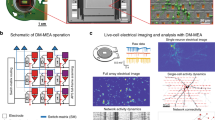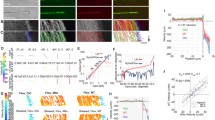In the era of molecular biology and atomic force microscopy, some important macroscopic issues such as simultaneous bidirectional axonal flow or neuronal multinucleosis remain unaddressed. However, these issues have to be addressed, because they distort the results of our current achievements. Using videorecording technique, we studied adhesive contacts between neurons and their processes and kinetics of anastomosis retraction between the cell bodies up to their complete fusion with introduction of neurites into the cell cytoplasm and formation of binuclear cells. Three proofs refuting the mechanism of binuclearity formation by amitosis are presented. Live trinuclear neurons without signs of amitotic division were identified. Electron microscopy showed that fusion of many living neurons into one simplest during centrifugation of isolated cells.
Similar content being viewed by others
References
Sergeeva SS, Sotnikov OS, Paramonova NV. Method for creating a neurophysiological model of a simple nervous system possessing reverberation. Ross. Fiziol. Zh. 2020;106(9):1163-1169. doi: https://doi.org/10.31857/S0869813920080075. Russian.
Sotnikov OS. Reticular theory of Camillo Golgi and restructuring electrical synapses in syncytial perforations. Biol. Bull. 2019;46(2):128-143.
Yarygin NE, Yarygin VN. Pathological and Adoptive Changes of Neurons. Moscow, 1973. Russian.
Ackman JB, Siddiqi F, Walikonis RS, LoTurco JJ. Fusion of microglia with pyramidal neurons after retroviral infection. J. Neurosci. 2006;26(44):11413-11422. doi: https://doi.org/10.1523/JNEUROSCI.3340-06.2006
Alvarez-Dolado M, Pardal R, Garcia-Verdugo JM, Fike JR, Lee HO, Pfeffer K, Lois C, Morrison SJ, Alvarez-Buylla A. Fusion of bone-marrow-derived cells with Purkinje neurons, cardiomyocytes and hepatocytes. Nature. 2003;425:968-973. doi: https://doi.org/10.1038/nature02069
Anastas SB, Mueller D, Semple-Rowland SL, Breunig JJ, Sarkisian MR. Failed cytokinesis of neural progenitors in citron kinase-deficient rats leads to multinucleated neurons. Cereb. Cortex. 2011;21(2):338-344. doi: https://doi.org/10.1093/cercor/bhq099
Bae JS, Han HS, Youn DH, Carter JE, Modo M, Schuchman EH, Jin HK. Bone marrow-derived mesenchymal stem cells promote neuronal networks with functional synaptic transmission after transplantation into mice with neurodegeneration. Stem Cells. 2007;25(5):1307-1316. doi: https://doi.org/10.1634/stemcells.2006-0561
Blümcke I, Wiestler OD. Gangliogliomas: an antriguing tumor entity associated with focal epilepsies. J. Neuropathol. Exp. Neurol. 2002;61(7):575-584. doi: https://doi.org/10.1093/jnen/61.7.575
Chen KA, Cruz PE, Lanuto DJ, Flotte TR, Borchelt DR, Srivastava A, Zhang J, Steindler DA, Zheng T. Cellular fusion for gene delivery to SCA1 affected Purkinje neurons. Mol. Cell. Neurosci. 2011;47(1):61-70. doi: https://doi.org/10.1016/j.mcn.2011.03.003
DiLorenzo DJ, Jankovic J, Simpson RK, Takei H, Powell SZ. Long-term deep brain stimulation for essential tremor: 12-year clinicopathologic follow-up. Mov. Disord. 2010;25(2):232-238. doi: https://doi.org/10.1002/mds.22935
Espejel S, Romero R, Alvarez-Buylla A. Radiation damage increases Purkinje neuron heterokaryons in neonatal cerebellum. Ann. Neurol. 2009;66(1):100-109. doi: https://doi.org/10.1002/ana.21670
Fèvre-Montange M, Szathmari A, Champier J, Mokhtari K, Chrétien F, Coulon A, Figarella-Branger D, Polivka M, Varlet P, Uro-Coste E, Fauchon F, Jouvet A. Pineocytoma and pineal parenchymal tumors of intermediate differentiation presenting cytologic pleomorphism: a multicenter study. Brain Pathol. 2008;18(3):354-359. doi: https://doi.org/10.1111/j.1750-3639.2008.00128.x
Hirohata S. Histopathology of central nervous system lesions in Behcet’s desease. J. Neurol. Sci. 2008;267(1-2):41-47. doi: https://doi.org/10.1016/j.jns.2007.09.041
Kawataki T, Sato E, Sato T, Kinouchi H. Anaplastic ganglioglioma with malignant features in both neuronal and glial components — case report. Neurol. Med. Chir. (Tokyo). 2010;50(3):228-231. doi: https://doi.org/10.2176/nmc.50.228
Kemp K, Gordon D, Wraith DC, Mallam E, Hartfield E, Uney J, Wilkins A, Scolding N. Fusion between human mesenchymal stem cells and rodent cerebellar Purkinje cells. Neuropathol. Appl. Neurobiol. 2011;37(2):166-178. doi: https://doi.org/10.1111/j.1365-2990.2010.01122.x
Kemp K, Gray E, Wilkins A, Scolding N. Purkinje cell fusion and binucleate heterokaryon formation in multiple sclerosis cerebellum. Brain. 2012;135(Pt 10):2962-2972. doi: https://doi.org/10.1093/brain/aws226
Magrassi L, Grimaldi P, Ibatici A, Corselli M, Ciardelli L, Castello S, Podestà M, Frassoni F, Rossi F. Induction and survival of binucleated Purkinje neurons by selective damage and aging. J. Neurosci. 2007;27(37):9885-9892. doi: https://doi.org/10.1523/JNEUROSCI.2539-07.2007
Martin-Padura I, Marighetti P, Gregato G, Agliano A, Malazzi O, Mancuso P, Pruneri G, Viale A, Bertolini F. Spontaneous cell fusion of acute leukemia cells and macrophages observed in cells with leukemic potential. Neoplasia. 2012;14(11):1057-1066. doi: https://doi.org/10.1593/neo.12736
Müller T. Light microscopic analysis of cellular networks in the pineal gland of the golden hamster as revealed by methylene blue labeling. Ital. J. Anat. Embryol. 2000;105(3):159-165.
Nern C, Wolff I, Macas J, von Randow J, Scharenberg C, Priller J, Momma S. Fusion of hematopoietic cells with Purkinje neurons does not lead to stable heterokaryon formation under noninvasive conditions. J. Neurosci. 2009;29(12):3799-3807. doi: https://doi.org/10.1523/JNEUROSCI.5848-08.2009.
Paltsyn A, Komissarova S, Dubrovin I, Kubatiev A. Increased cell fusion in cerebral cortex may contribute to poststroke regeneration. Stroke Res. Treat. 2013;2013:869327. doi: https://doi.org/10.1155/2013/869327
Paltsyn AA, Manukhina EB, Goryacheva AV, Downey HF, Dubrovin IP, Komissarova SV, Kubatiev AA. Intermittent hypoxia stimulates formation of binuclear neurons in brain cortex — a role of cell fusion in neuroprotection? Exp. Biol. Med. (Maywood). 2014;239(5):595-600. doi: https://doi.org/10.1177/1535370214523898
Richard JP, Leikina E, Langen R, Henne WM, Popova M, Balla T, McMahon HT, Kozlov MM, Chernomordik LV. Intracellular curvature-generating proteins in cell-to-cell fusion. Biochem. J. 2011;440(2):185-193. doi: https://doi.org/10.1042/BJ20111243
Sotnikov OS. Properties Live Axoplasm. New York, 2016.
Terashima T, Kojima H, Fujimiya M, Matsumura K, Oi J, Hara M, Kashiwagi A, Kimura H, Yasuda H, Chan L. The fusion of bone-marrow-derived proinsulin-expressing cells with nerve cells underlies diabetic neuropathy. Proc. Natl Acad. Sci. USA. 2005;102(35):12525-12530. doi: https://doi.org/10.1073/pnas.0505717102
Weimann JM, Charlton CA, Brazelton TR, Hackman RC, Blau HM. Contribution of transplanted bone marrow cells to Purkinje neurons in human adult brains. Proc. Natl Acad. Sci. USA. 2003;100(4):2088-2093. doi: https://doi.org/10.1073/pnas.0337659100
Zhu X, Siedlak SL, Wang Y, Perry G, Castellani RJ, Cohen ML, Smith MA. Neuronal binucleation in Alzheimer disease hippocampus. Neuropathol. Appl. Neurobiol. 2008;34(4):457-465. doi: https://doi.org/10.1111/j.1365-2990.2007.00908.x
Author information
Authors and Affiliations
Corresponding author
Additional information
Translated from Kletochnye Tekhnologii v Biologii i Meditsine, No. 2, pp. 79-84, June, 2021
Rights and permissions
About this article
Cite this article
Sotnikov, O.S. Binucleated and Multinucleated Neurons are Formed by Fusion. Bull Exp Biol Med 171, 508–512 (2021). https://doi.org/10.1007/s10517-021-05261-w
Received:
Published:
Issue Date:
DOI: https://doi.org/10.1007/s10517-021-05261-w




